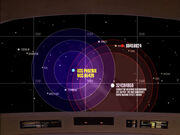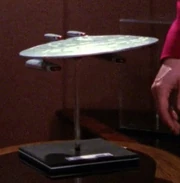The Nebula-class was a type of Federation starship that was in service in Starfleet during the second half of the 24th century.
History[]
Construction of the Nebula-class was spearheaded under the authority of the Yoyodyne Division, and ranged in construction dates from as early as 2363 to as late as 2367. Vessels including the USS Phoenix, the USS Prometheus, and the USS Sutherland were constructed at this time at both the 40 Eridani A Starfleet Construction Yards (the first two ships) and the San Francisco Fleet Yards. (TNG: "The Wounded", "Redemption II"; DS9: "Second Sight", dedication plaques)
The mission profile of the Nebula-class varied from performing various scientific and exploratory roles to conducting patrol and transport duties. (DS9: "Second Sight", "Explorers"; TNG: "Brothers" set artwork; TNG: "Sarek", "The Game")
The Nebula-class was present in several major Federation engagements against the Borg, including the Battle of Wolf 359 and the Battle of Sector 001. (DS9: "Emissary"; Star Trek: First Contact) They were also present in numerous Dominion War battles, including the Second Battle of Chin'toka and Battle of Cardassia. (DS9: "The Changing Face of Evil", "What You Leave Behind") A Nebula-class starship, the USS Farragut, was one of three ships sent to transport the crew of the USS Enterprise off Veridian III after the saucer section crash landed due to a battle with a Klingon vessel. (Star Trek Generations).
The Nebula-class was still in Starfleet service by 2378. (VOY: "Endgame")
By 2401, one ship of the class, the USS Lexington, was retired, and preserved in the Fleet Museum above Athan Prime. (PIC: "The Bounty", "Võx")
Technical data[]
Design[]

Nebula- and Galaxy-class starships
The Nebula-class shared a similar design lineage with its larger Galaxy-class counterpart, notably its primary and secondary hulls and warp nacelles. (TNG: "The Wounded", etc.)
It is unknown, precisely, which class spawned the other, or if they were designed simultaneously. The only chronological evidence that exists can be determined by a comparison of dedication plaques, which reveals that the Nebula-class Phoenix was commissioned (on stardate 40250.5) just a short time before the launch (stardate 40759.5) of the Galaxy-class USS Enterprise-D.
The Nebula-class was composed of two hull sections; the saucer-shaped primary hull mounted atop the secondary hull, with two warp nacelles mounted on either side of the secondary hull, directly below the primary hull. (TNG: "The Wounded", etc.)
Atop the primary hull was a superstructure which could support a variety of modules, such as the inclusion of a triangular platform, fitted with torpedo launchers, an oval platform, or additional warp nacelles. (TNG: "Redemption II", "The Wounded", "Unification I")
It remains unclear what the function of the Phoenix's superstructure was; however, it may be connected with the ship using a "high-energy sensor sweep." According to the Star Trek Encyclopedia, 2nd ed., p. 317, the superstructure was usually used for sensors, but could be customized for different mission types.
By 2375, the Nebula-class was reconfigured slightly to include more of a Galaxy-class style secondary hull and deflector dish. (DS9: "The Changing Face of Evil")
The reconfigured primary and secondary hull configurations were a result of the transition from studio model to CGI model.
By 2369, the Nebula-class served among historic model designs used in the classroom aboard Deep Space 9. (DS9: "The Nagus")
Defensive systems[]

Nebula class weapons range (left)
The Nebula-class was equipped with "a huge arsenal", at least according to Cardassian Gul Macet, which included multiple phaser banks and torpedo launchers. The Nebula-class had a maximum effective weapons range slightly below 300,000 kilometers. (TNG: "The Wounded")
The typical offensive arsenal of the Nebula-class included a torpedo launcher located on the secondary hull above the deflector dish, and on some variants, a torpedo launcher located on the superstructure located above the primary hull. (Star Trek: First Contact; TNG: "Redemption II") Phaser positions included the forward-most part of the primary hull, and on the secondary hull, below the deflector dish. (VOY: "Non Sequitur", "Message in a Bottle", "Endgame"; DS9: "Emissary")
While additional phaser strips are visible on the studio model, special effects have only revealed phaser fire from the two above-mentioned locations.
While considered more than a match for a Cardassian supply ship, the Nebula-class was also capable of successfully withstanding a direct hit from a Cardassian warship, as a result of an unshielded attack. (TNG: "The Wounded") They were, however, unable to single-handedly withstand an assault from a wing of Cardassian destroyers. (DS9: "Waltz")
Some Nebula-class starships, including the Phoenix, used a "high-energy sensor sweep" that cycled every 5.5 minutes. Between each of those cycles, a "window" of a fiftieth of a second would open, requiring the ship's shields to be realigned. (TNG: "The Wounded")
Propulsion systems[]
The propulsion systems for the Nebula-class were constructed under the authority of Yoyodyne Propulsion Systems. (TNG: "Redemption II" dedication plaque)
A careful inspection of the Nebula-class model reveals that it has no visible impulse engines. In an entry on Doug Drexler's weblog, Rick Sternbach indicated that he envisioned the ship's impulse drives as being hidden behind baffles to scatter their signature for stealth reasons. He added that "modern" Starfleet vessel impulse engines operated on little conventional rocket thrust anyways, being more of a sub-warp subspace drive. [1](X)
The engines of a Nebula-class needed to operate with a mixture above ninety percent in order to successfully leave orbit of a planet. Additionally, the starboard power coupling was located adjacent to decks ten through twelve. In 2368, the maximum warp for the class was warp 9.3. (TNG: "Redemption II") By 2370, the theoretical maximum speed for the warp drive of Nebula-class starships, including the USS Prometheus, was warp 9.5. When fine-tuned, the warp drive could be pushed to warp 9.6. (DS9: "Second Sight") By 2374, the USS Bonchune was able to pursue and catch the Prometheus-class USS Prometheus, that was traveling at warp 9.9. (VOY: "Message in a Bottle")
In an alternate timeline, the Nebula-class was described as being "a lot faster" than a Yellowstone-class runabout. (VOY: "Non Sequitur")
Auxiliary craft[]
Nebula-class starships were equipped with a variety of auxiliary craft, including the Type 6 and Type 7 shuttlecraft, as well as the smaller Type 15 shuttlepod, and other large shuttlecraft. (DS9: "Waltz", "Wrongs Darker Than Death or Night", "Tears of the Prophets", "Second Sight"; Star Trek Generations)
Visual inspection of the underside of the saucer suggests that ships of the class also carried a captain's yacht, much as Galaxy-class starships did.
Interior design[]
Bridge[]
Other interiors[]
The sets used for the USS Honshu were a reuse of the USS Defiant hallway set and the USS Voyager brig set.
Ships commissioned[]
- Named
- Uncertain
- Unnamed
Appendices[]
Appearances[]

The Deep Space Nine title sequence featuring a Nebula-class ship
In addition to the episode-specific appearances below, the Nebula-class, in the form of the USS Leeds, began appearing in every title sequence of Star Trek: Deep Space Nine from "The Way of the Warrior" to "What You Leave Behind".

Desktop model
It also made several appearances as a desktop model in TNG: "Future Imperfect", DS9: "The Nagus" and "The Way of the Warrior".
- TNG:
- Star Trek films:
- DS9:
- VOY:
- PIC:
- "The Bounty"
- "Võx"
Background information[]
The Nebula-class was referred to by name for the first time in the chart seen on the USS Enterprise-D main bridge in "Brothers". (This chart was seen again, with modifications, in "Chain Of Command, Part I" and in several episodes afterwards, in the observation lounge of the Enterprise-D.) Nebula-class was referred to on the dedication plaques for the Phoenix ("The Wounded"), the Sutherland ("Redemption II"), and the Prometheus ("Second Sight"). Nebula-class was referred to by name in "The Wounded" and "Non Sequitur". It was additionally referred to by name in the script notes for "Redemption II".
Studio models[]
- See main article: Nebula-class model
Technical Manual[]
The following specifications and defenses come from the Star Trek: Deep Space Nine Technical Manual (p. 152):
- Production Base: ASDB Integration Facility, Utopia Planitia Fleet Yards, Mars
- Type: Explorer
- Accommodation: 750 officers and crew; 130 visiting personnel; 9,800 personal evacuation limit
- Power Plant: One 1,500 plus Cochrane warp core feeding two nacelles; one impulse system
- Dimensions: Length, 442.23 meters; beam, 318.11 meters; height: 130.43 meters
- Mass: 3,309,000 metric tons
- Performance: Warp 9.6 for 12 hours (STD); warp 9.9 for 12 hours (UPRTD)
- Armament: Eight type-10 phaser emitters; two photon torpedo launchers
Apocrypha[]

A Nebula-class ship in Star Trek: Legacy
A cross section and overview of the ship is given in issue 154 of Star Trek: Communicator, particularly focusing on the USS Nebula (NCC-60147) (β). The cross section shows that the ship is capable of saucer separation, has eight type-X phaser arrays and three photon torpedo launchers, and a mass of 3,309,000 metric tons. One inconsistency among the graphics has the registry number "NCC-60000" on the nacelle pylon. All artwork used was provided by Tim Earls.
In the video games Star Trek: Armada and Star Trek: Armada II, the Nebula-class is depicted as a "science ship"; that is, it has four special weapons where other ship classes have just one. The special weapons allow the Nebula-class to disrupt enemy shields, destroy incoming torpedoes, temporarily duplicate an allied ship, or send an engineering team to an allied ship or station to repair its systems.
In the video game Star Trek: Bridge Commander, there are four Nebula-class vessels. Three of these, the USS Nightingale (β), USS Khitomer (β), and USS Berkeley (β), appear to be made specifically for the game and do not appear anywhere in Star Trek canon. The fourth Nebula-class vessel featured in the game is actually a canon ship, the USS Prometheus (NCC-71201), though it is the only one that doesn't play an important role in the game.
In Star Trek: The Next Generation - Birth of the Federation the Nebula-class is the strike cruiser of the Federation, a short range combat vessel mostly intended for planetary bombardment.
In Star Trek Online, the Nebula-class is an "advanced research science vessel" available to players ranked Commander or higher, that can create tachyon detection fields and grids which boost stealth detection and sensor abilities.
External links[]
- Nebula class at Memory Beta, the wiki for licensed Star Trek works
- Proto-Nebula Class Reconstruction at Ex Astris Scientia
- Nebula Class Observations at Ex Astris Scientia

















